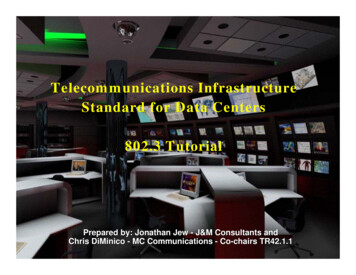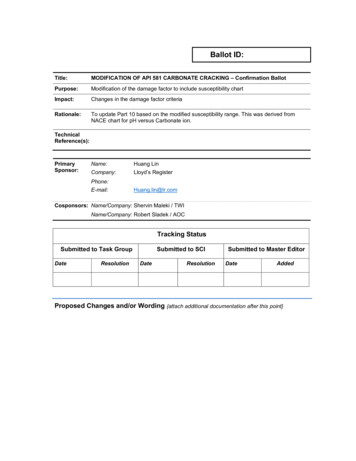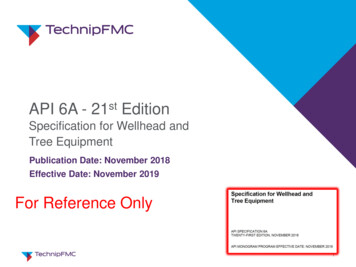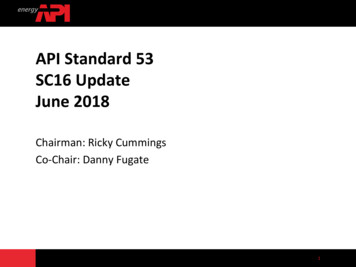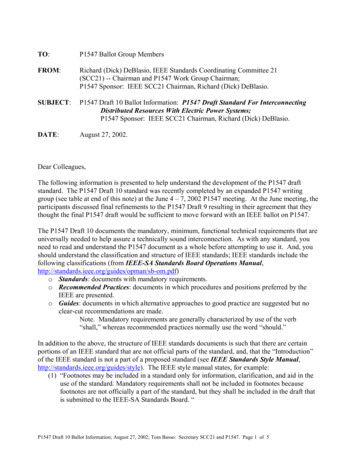
Transcription
TO:P1547 Ballot Group MembersFROM:Richard (Dick) DeBlasio, IEEE Standards Coordinating Committee 21(SCC21) -- Chairman and P1547 Work Group Chairman;P1547 Sponsor: IEEE SCC21 Chairman, Richard (Dick) DeBlasio.SUBJECT:P1547 Draft 10 Ballot Information: P1547 Draft Standard For InterconnectingDistributed Resources With Electric Power Systems;P1547 Sponsor: IEEE SCC21 Chairman, Richard (Dick) DeBlasio.DATE:August 27, 2002.Dear Colleagues,The following information is presented to help understand the development of the P1547 draftstandard. The P1547 Draft 10 standard was recently completed by an expanded P1547 writinggroup (see table at end of this note) at the June 4 – 7, 2002 P1547 meeting. At the June meeting, theparticipants discussed final refinements to the P1547 Draft 9 resulting in their agreement that theythought the final P1547 draft would be sufficient to move forward with an IEEE ballot on P1547.The P1547 Draft 10 documents the mandatory, minimum, functional technical requirements that areuniversally needed to help assure a technically sound interconnection. As with any standard, youneed to read and understand the P1547 document as a whole before attempting to use it. And, youshould understand the classification and structure of IEEE standards; IEEE standards include thefollowing classifications (from IEEE-SA Standards Board Operations m.pdf)o Standards: documents with mandatory requirements.o Recommended Practices: documents in which procedures and positions preferred by theIEEE are presented.o Guides: documents in which alternative approaches to good practice are suggested but noclear-cut recommendations are made.Note. Mandatory requirements are generally characterized by use of the verb“shall,” whereas recommended practices normally use the word “should.”In addition to the above, the structure of IEEE standards documents is such that there are certainportions of an IEEE standard that are not official parts of the standard, and, that the “Introduction”of the IEEE standard is not a part of a proposed standard (see IEEE Standards Style Manual,http://standards.ieee.org/guides/style). The IEEE style manual states, for example:(1) “Footnotes may be included in a standard only for information, clarification, and aid in theuse of the standard. Mandatory requirements shall not be included in footnotes becausefootnotes are not officially a part of the standard, but they shall be included in the draft thatis submitted to the IEEE-SA Standards Board. “P1547 Draft 10 Ballot Information; August 27, 2002; Tom Basso: Secretary SCC21 and P1547. Page 1 of 5
(2) “Informative annexes are included in a standard for information only and are not an officialpart of the standard itself. .”(3) and, specifically for a bibliography, “Complete and current information for bibliographicentries shall be supplied by the working group. The bibliography always shall be aninformative numbered annex that appears as either the first or last annex of the standard.”In general, further information on IEEE standards can be found at the IEEE web site.The IEEE P1547 draft standard is the first of a series of standards documents being developed bySCC21 concerning distributed resources interconnection. The titles of the additional (draft)documents in that series follow (see listing near the end of this memo for the scope and purpose ofthese additional IEEE standards development projects). IEEE P1589 Draft Standard For Conformance Test Procedures for EquipmentInterconnecting Distributed Resources With Electric Power Systems; IEEE P1608 Draft Application Guide for IEEE Std. 1547 Standard for InterconnectingDistributed Resources With Electric Power Systems, and; IEEE P1614 Draft Guide for Monitoring, Information Exchange, and Control ofDistributed Resources Interconnected With Electric Power Systems.Since its inception, the SCC21 P1547 development activity has moved forward on a fast track basiswith the unwavering support from industry, utilities, government, and general interest groups andindividuals. This support has grown and evolved from the fundamental founding principles topursue developing a P1547 standard that states the mandatory requirements that are universallyneeded for interconnecting, while being technology neutral and covering all sizes of distributedresources (DR). These principles have been reviewed and debated at P1547 meetings time and timeagain; the only major clarification being that the standard would cover aggregate size up to 10MVA for DR connected to the distribution level of the electric power system (EPS).Along with the growing support for an interconnection standard, the P1547 Work Group (WG)membership has greatly increased in numbers, while the fundamental principles have continued asthe basis for work group development consensus. Additionally, there has been a great outpouring ofother parties having expressed their interest in P1547. We have seen a multitude of comments andsuggested remedies for additional content and clauses for inclusion in P1547. Many of thosecomments and clauses have previously been discussed in various P1547 meetings. In large part forthose comments, attendees agreed the comments were technically valid and appropriateinterconnection concerns that should be pursued. However, it was also determined that many ofthose comments extend beyond the fundamental principles debated and previously found agreeableby the P1547 work group.Prior to this P1547 Draft 10 ballot action, there was a ballot action on P1547 Draft 7 and subsequentrecirculation ballot vote on P1547 Draft 8. Those ballot results respectively achieved 91% and 96%return of ballots, a very high return indicative of the ballot group’s commitment to achieve asuccessful ballot action. However, each of those ballot results ended in 66% affirmatives whereasIEEE requires 75% affirmatives in order to be able to proceed to submit the draft standard to theIEEE Standards Board for their approval as an IEEE standard. This P1547 Draft 10 is a significantchange from Drafts 7 and 8.P1547 Draft 10 Ballot Information; August 27, 2002; Tom Basso: Secretary SCC21 and P1547. Page 2 of 5
Based on consideration of all the P1547 Drafts 7 and 8 rewording proposals and ongoing comments,the following approach was undertaken to establish Draft 9. The review of Draft 8 was a pointedand focused review by the P1547 work group and ballot group members at past P1547 meetings.During those reviews it was established which clauses were aligned with the P1547 fundamentalsand that state the mandatory, minimum, functional technical requirements that are universallyneeded to help assure a technically sound interconnection. And, it was recommended how theclauses should be revised.The review of P1547 Draft 8 proceeded on a clause-by-clause basis. The first part of the P1547Draft 8 review approach was to remove the information that was appropriate for other standards ordocuments. That type of information includes procedure requirements, application guidance, safetypractices , and, supporting information such as needed for protocols, specific DR-EPS applications,equipment-specific criteria (e.g., distributed generators or distribution transformers), type-specificutility grid configurations, operational aspects, regulatory aspects, etc. The material that wasremoved is being considered for its recommendation under the P1589 (testing) project, or the P1608(application guide to P1547) project, or the P1614 guide for monitoring/control project (see tablebelow), or, for recommendation for either additional future standards projects, or recommendationfor technical or regulatory review and study.After the P1547 work group completed the first clause-by-clause review of the P1547 Draft 8, theresulting refined “P1547 outline” was again reviewed, this time for rewording recommendationstoward alignment with the fundamental principles that P1547 shall state the mandatory, minimum,functional technical requirements that are universally needed to help assure a technically soundinterconnection. As part of this review, the P1547 expanded writing group held three meetings towrite the final wording that result in the P1547 Draft 9. The establishment of P1547 Draft 9involved significant changes since draft 8. That P1547 Draft 9 was based on the considerationssummarized above, with more details indicated in the January 31, 2002 meeting agenda/notices andminutes / (folder “notices” file“Notice20020131” and folder “minutes” file “P1547Minutes20020131).”The P1547 Draft 9 was then sent by email for comment by the P1547 work group and the pastP1547 ballot group. The comments and recommended rewording that were received werecompiled, and, distributed and discussed at the June 4 – 7, 2002 work group meeting. Additionally,the attendees at the June meeting provided and discussed additional comments and recommendedrewording. At the June meeting, the expanded P1547 writing group participated in the opendiscussions and also directly interacted with individual attendees, discussing concerns andrecommended rewording for the P1547 draft. Based on the writing group’s final deliberations, theyarrived at the P1547 Draft 10 wording.P1547 Draft 10 Ballot Information; August 27, 2002; Tom Basso: Secretary SCC21 and P1547. Page 3 of 5
-------------------- ------------------------------------- ------------------------------------IEEE SCC21 Interconnection Standards Development ProjectsTitle: P1547 Draft Standard For Interconnecting Distributed Resources With ElectricPower Systems.o Scope. This Standard establishes criteria and requirements for interconnection of distributedresources (DR) with electric power systems (EPS).o Purpose. This document provides a uniform standard for interconnection of distributedresources with electric power systems. It provides requirements relevant to the performance,operation, testing, safety considerations, and maintenance of the interconnection.Title: P1589 Draft Standard for Conformance Tests Procedures For EquipmentInterconnecting Distributed Resources With Electric Power Systemso Scope. This Standard specifies the type, production, and commissioning tests that shall beperformed to demonstrate that interconnection functions and equipment of a distributedresource (DR) conform to IEEE (Draft) Std P1547.o Purpose. Interconnection equipment that connects distributed resources (DR) to an electricpower system (EPS) must meet the requirements specified in IEEE (Draft) Standard P1547.Standardized test procedures are necessary to establish and verify compliance with thoserequirements. These test procedures must provide both repeatable results, independent oftest location, and flexibility to accommodate a variety of DR technologies.Title: P1608 Draft Application Guide For “IEEE Draft Standard 1547 InterconnectingDistributed Resources With Electric Power Systems”o Scope. This Guide provides technical background and application details to support theunderstanding of IEEE P1547 (Draft) Standard for Interconnecting Distributed Resourceswith Electric Power Systems.o Purpose. This document facilitates the use of IEEE P1547 by characterizing the variousforms of distributed resource technologies and the associated interconnection issues.Additionally, the background and rationale of the technical requirements are discussed interms of the operation of the distributed resource interconnection with the electric powersystem. Presented in the document are technical descriptions and schematics, applicationsguidance and interconnection examples to enhance the use of IEEE P1547.Title: P1614 Draft Guide for Monitoring, Information Exchange, and Control ofDistributed Resources Interconnected With Electric Power Sourceso Scope. This document provides guidelines for monitoring, information exchange, andcontrol for distributed resources (DR) interconnected with electric power systems (EPS).o Purpose. This document facilitates the interoperability of one or more distributed resourcesinterconnected with electric power systems. It describes functionality, parameters andmethodologies for monitoring, information exchange and control for the interconnecteddistributed resources with, or associated with, electric power systems. Distributed resourcesinclude systems in the areas of fuel cells, photovoltaics, wind turbines, microturbines, otherdistributed generators, and, distributed energy storage systems.----------------- -------------------- ------------P1547 Draft 10 Ballot Information; August 27, 2002; Tom Basso: Secretary SCC21 and P1547. Page 4 of 5
IEEE SCC21 P1547 Writing Group Members (March Ackermann@ieee.orgBasso, Secretary thomas gy.comDeBlasio, Chair richard h l .ul.comTelephone(610) 395-7333(303) 275-3753(604) 488-2107(505) 241-2642(973) 966-2474(248) 427-2221(303) 275-4333(859) 744-4812 ext. 389(914) 486-5417(504) 576-7007(218) 722-1972 ext. 2654(703) 356-1300 x203(650) 855-2872(585) 624-6826(412) 264-6148(704) 382-4252(763) 574-5055(517) 788-0027(208) 526-9522(415) 973-2223(518) 385-5370(925) 552-1330(916) 966-9060(847) 272-8800 x43051[End]P1547 Draft 10 Ballot Information; August 27, 2002; Tom Basso: Secretary SCC21 and P1547. Page 5 of 5
IEEE P1547/ D10 6/21/02IEEE P1547/ D10Draft Standard for Interconnecting DistributedResources with Electric Power SystemsSponsored by theIEEE Standards Coordinating Committee 21 (IEEE SCC21) onFuel Cells, Photovoltaics, Dispersed Generation, and Energy Storageof the IEEE Standards AssociationCopyright 2002 by the Institute of Electrical and Electronics Engineers, Inc.Three Park AvenueNew York, New York 10016-5997, USAAll rights reserved.This document is an unapproved draft of a proposed IEEE-SA Standard – USE AT YOUR OWN RISK. As such,this document is subject to change. Permission is hereby granted for IEEE Standards Committee participants toreproduce this document for purposes of IEEE standardization activities only. Prior to submitting this document toanother standard development organization for standardization activities, permission must first be obtained from theManager, Standards Licensing and Contracts, IEEE Standards Activities Department. Other entities seekingpermission to reproduce portions of this document must obtain the appropriate license from the Manager, StandardsLicensing and Contracts, IEEE Standards Activities Department. The IEEE is the sole entity that may authorize theuse of IEEE owned trademarks, certification marks, or other designations that may indicate compliance with thematerials contained herein.IEEE Standards Activities DepartmentStandards Licensing and Contracts445 Hoes Lane, P.O. Box 1331Piscataway, NJ 08855-1331, USAT. Basso, Secretary of P1547 Work Group of IEEE SCC21National Renewable Energy Laboratory – MS16141617 Cole BlvdGolden, CO, 80401-3393 USACopyright 2002 IEEE. All rights reserved. This is an unapproved IEEE Standards Draft, subject to change. Page 1
IEEE P1547/ D10 6/21/02Introduction(This introduction is not part of IEEE P1547 Draft Standard for Distributed Resources Interconnected with ElectricPower Systems.)This IEEE 1547 standard is the first of a series of standards documents being developed by SCC21 concerningdistributed resources interconnection. The titles of the additional documents in that series follow. IEEE P1589 Draft Standard For Conformance Test Procedures for Equipment InterconnectingDistributed Resources With Electric Power Systems; IEEE P1608 Draft Application Guide for IEEE Std. 1547 Standard for Interconnecting DistributedResources With Electric Power Systems, and; IEEE P1614 Draft Guide for Monitoring, Information Exchange, and Control of Distributed ResourcesInterconnected With Electric Power Systems.This first publication of IEEE P1547 is an outgrowth of the changes in the environment for production and deliveryof electricity and builds on prior IEEE recommended practices and guidelines developed by Standards CoordinatingCommittee 21 Fuel Cells, Photovoltaics, Dispersed Generation, and Energy Storage (SCC21), e.g., IEEE Std 9292000 IEEE Recommended Practice for Utility Interface of Photovoltaic (PV) Systems, and Standards CoordinatingCommittee 23 Dispersed Storage and Generation, e.g., IEEE Std 1001-1988 Guide for Interfacing DispersedStorage and Generation Facilities with Electric Utility Systems.Traditionally, utility electric power systems (EPS) were not designed to accommodate active generation and storageat the distribution level. The technologies and operational concepts to properly integrate distributed resources (DR)into the existing EPS continue to be further developed to fully realize benefits and to avoid negative impacts onsystem reliability and safety.There is a critical need to have a single document of consensus standard technical requirements for DRinterconnection rather than having to conform to numerous local practices and guidelines. This standard addressesthat critical need by providing uniform criteria, and requirements relevant to the performance, operation, testing,safety considerations, and maintenance of the interconnection.The intent of this standard is to define the technical requirements in a manner that can be universally adopted. Theuniversality relates not only to the technical aspects, but also to the adoption of this standard as being pertinentacross a number of industries and institutions, e.g., hardware manufacturers, utilities, energy service companies,codes and standards organizations, regulators and legislators, and other interested entities.This standard focuses on the technical specifications for, and testing of, the interconnection itself, and not on thetypes of the DR technologies. This standard aims to be technology neutral, although cognizant that the technicalattributes of DR and the types of EPSs do have a bearing on the interconnection requirements. The addition of DRto an EPS will change the system and its response in some manner. Although this standard establishes criteria andrequirements for interconnection, this standard is not a design handbook nor is it an application guideline. Thisstandard provides the minimum functional technical requirements that are universally needed to help assure atechnically sound interconnection. Any additional local requirements should not be implemented to the detriment ofthe functional technical requirements of this standard.It is beyond the scope of this standard to address the methods used for performing EPS system impact studies,mitigating limitations of the Area EPS, or for addressing the business or tariff issues associated withinterconnection.Copyright 2002 IEEE. All rights reserved. This is an unapproved IEEE Standards Draft, subject to change. Page 2
IEEE P1547/ D10 6/21/02ParticipantsAt the time this standard was completed, the Standards Coordinating Committee 21, on Fuel Cells, Photovoltaics,Dispersed Generation, and Energy Storage had the following membership.Richard DeBlasio, ChairThomas S. Basso, SecretarySteve Chalmers, Vice ChairJerryJayJames M.Douglas C.N. RichardWilliam FeeroGoodmanHechtBarryJoseph L.BenjaminRobertJohnJohnJohnTimothy sWohlgemuthZgonenaAt the time this standard was completed, the Distributed Resources and Electric Power SystemsInterconnection Working Group (P1547 WG) of the Standards Coordinating Committee 21 (SCC21), onFuel Cells, Photovoltaics, Dispersed Generation, and Energy Storage had the following membership whoparticipated in the preparation of this standard.Richard D. DeBlasio, ChairFrank Goodman, Vice e(Pete)(Rick)A.A.C.W.L. S.Joseph L. Koepfinger, Vice ChairThomas S. Basso, hn BrockschinkN. (Mac) raCaireCalderonCantwellAnthony hapmanCopyright 2002 IEEE. All rights reserved. This is an unapproved IEEE Standards Draft, subject to change. Page 3
IEEE P1547/ D10 ve) P.(Bill) J.L.M.T.M.W.C.W.A.E.N.T.G. (Bert)C.A.A.(Steve) E.W.C.R.(Tom) yBryanDavidChristopherPaulN. iamC. ly(Herbert) onHunchukJ.HylandIannucci(Mike) R. IboldCopyright 2002 IEEE. All rights reserved. This is an unapproved IEEE Standards Draft, subject to change. Page 4
IEEE P1547/ D10 obbKurtBrenonLjubomir(Christopher) gleyLansingLarsenLarsonLaufenbergLawrenceLe onMelzl(Mike)MichaudMikonowiczMoenL. (Larry) karadoNapikoskiNarangNealD. (Brad) sR.Copyright 2002 IEEE. All rights reserved. This is an unapproved IEEE Standards Draft, subject to change. Page 5
IEEE P1547/ D10 yPaulaDaveRaoTonyW.(Pat) kSkokSmithSmithSt. uis(Betty) A. Van HoldeVaziriVentreVollkommerWalkerWall(Carl T.) WallA.Walling(Dan) J. WardWashom(Jim)WattsWenger(Randy) esA.WilkinsH.WilliamsWillsWindWohlgemuthWolkWongV. V. S. YallaYangW.ZainingerP.ZgonenaZhang(Don) W. ZipseZubietaCopyright 2002 IEEE. All rights reserved. This is an unapproved IEEE Standards Draft, subject to change. Page 6
IEEE P1547/ D10 6/21/02The following working group members participated in finalizing the development of the document withworking group inputs, and in facilitating the development of those inputs throughout the standardsdevelopment process:William J.Thomas S.M. N. (Mac)Stephan P.James M.Murray W.Richard D.Paul A.ThomasLynndaThomas W.N. DolloffDuffyEllErnstFriedmanFrankClarkJoseph L.Robert L. (Larry)Gary L.CharlesGaryChaseReigh A.CharlesRobertTimothy tSunWallingWhitakerWichertZgonenaCopyright 2002 IEEE. All rights reserved. This is an unapproved IEEE Standards Draft, subject to change. Page 7
IEEE P1547/ D10 6/21/02CONTENTSINTRODUCTION . 21.0OVERVIEW. 101.1Scope . 101.2Purpose . 101.3Limitations . 102.0REFERENCES. 123.0DEFINITIONS AND ACRONYMS. 133.1Definitions . 133.2Acronyms . 154.0 INTERCONNECTION TECHNICAL SPECIFICATIONS ANDREQUIREMENTS . 164.1General Requirements . 164.1.1Voltage Regulation . 164.1.2Integration with Area EPS Grounding. 164.1.3Synchronization. 164.1.4Distributed Resources on Distribution Secondary Grid and Spot Networks. 164.1.4.1 Distribution Secondary Grid Networks . 164.1.4.2 Distribution Secondary Spot Networks . 174.1.5Inadvertent Energization of the Area EPS. 174.1.6Monitoring Provisions . 174.1.7Isolation Device. 174.1.8Interconnect Integrity . 174.1.8.1 Protection from Electromagnetic Interference. 174.1.8.2 Surge Withstand Performance. 184.1.8.3Paralleling Device. 184.2Response to Area EPS Abnormal Conditions . 184.2.1Area EPS Faults. 184.2.2Area EPS Reclosing Coordination . 184.2.3Voltage . 184.2.4Frequency .
IEEE P1608 Draft Application Guide for IEEE Std. 1547 Standard for Interconnecting Distributed Resources With Electric Power Systems, and; IEEE P1614 Draft Guide for Monitoring, Inf
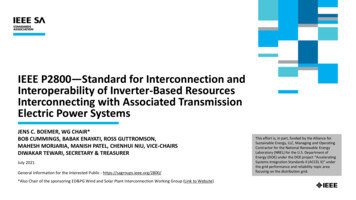
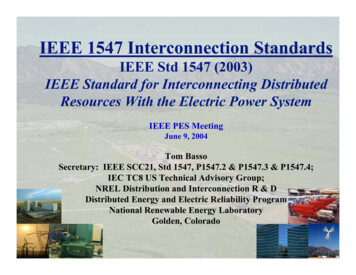

![API Ballot: [Ballot ID] – API 510 & API 570, Deferrals, Rev05](/img/5/api510andapi570deferralsrev5.jpg)
